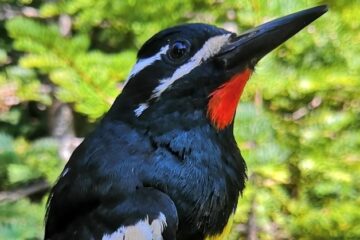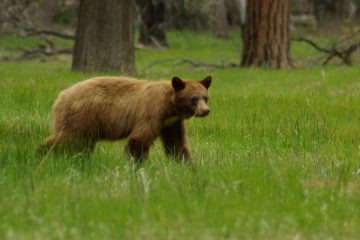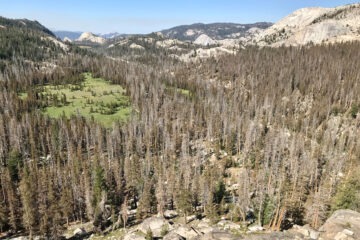Picture this: You’re hiking in Yosemite’s high country, with a pack stuffed with food (in a bear-proof canister!), clothes and gear. The sun is dipping toward the horizon. You spot a small lake near the trail, surrounded by pines and lush grass. There’s plenty of dry wood nearby to build a fire, and a toppled tree trunk that looks like an inviting bench.
What a perfect place to camp! you think. Comfortable, convenient, untouched and quiet. Five stars!
But then … you remember your Leave No Trace (LNT) lessons, and hike on a little farther.
Wait, what? What’s wrong with that plush waterfront spot?
Setting up camp on soft ground, in an undisturbed area, can have inadvertent but serious consequences. One study found that a single night of camping in a previously unimpacted area reduced plant life on the site by 60 percent; four nights of camping removed all but 20 percent of the site’s vegetation. In addition to damaging flora, inappropriate campsites can increase erosion, expose tree roots, and compact soil, limiting water- and nutrient-retention. Some spots can take years or decades to rebound.
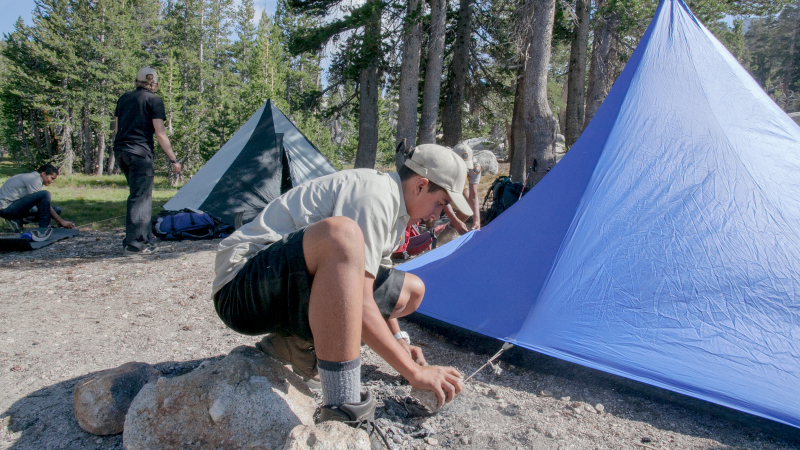
Participants in the WildLink Career Connection program learn key wilderness travel skills, including how to minimize their impact while camping in the backcountry. Photo: Yosemite Conservancy/Keith Walket
Between 2015 and 2017, nearly 600,000 people camped in Yosemite’s backcountry. More people are experiencing the wilderness, heeding the call of the mountains (and meadows and woodlands). But not everyone who ventures out of the frontcountry is equipped with the knowledge, skills and gear necessary to pass through the landscape without leaving a lasting mark.
Yosemite’s Wilderness Restoration Program works to address that challenge.
With support from our donors, Yosemite restoration staff, volunteers and high-school-age Student Conservation Association crews head into the backcountry to reverse and prevent detrimental environmental impacts. In a given year, they might cover anywhere from 7,000 to 24,000 acres of the Yosemite Wilderness, the vast undeveloped landscape that accounts for nearly 95% of the park. Their field season is necessarily compressed to summer and early autumn: Snow typically melts late at high elevations, and starts falling again well before winter.
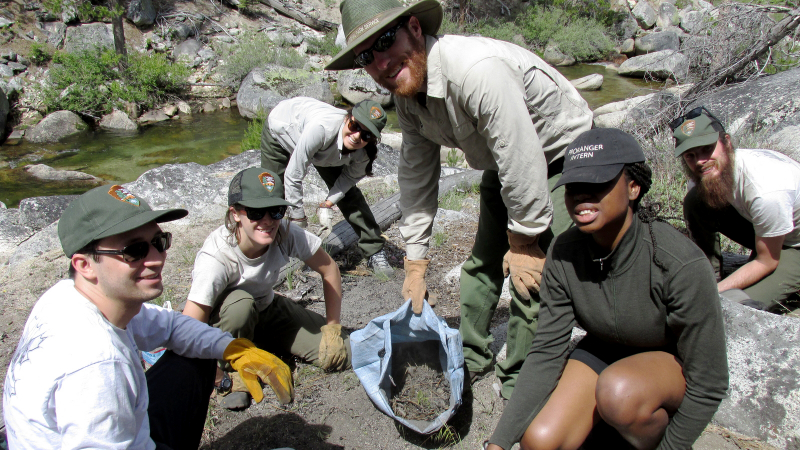
Keep It Wild crew members work together to find and restore impacted areas in the Yosemite Wilderness. Photo: Courtesy of NPS
This summer, staff and volunteer crews plan to survey and restore sites in Tuolumne Meadows, Lyell Canyon and Little Yosemite Valley, along Glacier Point Road and Yosemite Creek, and in the park’s southern and northern reaches (such as Chain Lakes, Ostrander Lake, Dorothy Lake and Jack Main Canyon). The five-week SCA crews start their stretch in the park with orientations on local flora and fauna, wilderness navigation, and restoration techniques, before digging into their itinerary, which this year includes places such as Sunrise Lakes, Long Meadow and Clouds Rest.
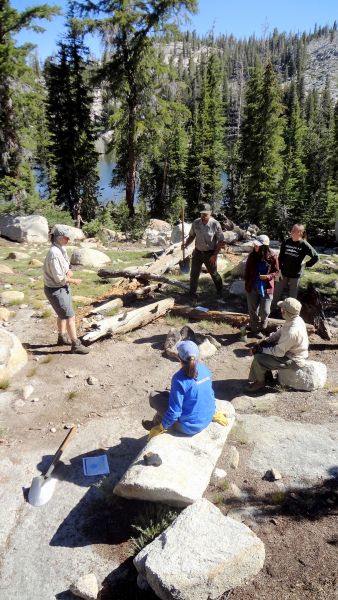
Student Conservation Association members learn wilderness restoration techniques in Yosemite’s backcountry. Photo: Courtesy of NPS
Some of Yosemite’s wilderness crews “rove” the backcountry, backpacking from point to point and camping wherever they finish work for the day. Others operate out of base camps, hiking to and from a central location to nearby worksites. Regardless of their approach, all crews apply LNT tactics to minimize their impact while erasing traces of other trekkers. They camp on resilient surfaces, use large bags or cans to carry water to camp (to minimize plant-trampling on trips to and from streams or lakes), and help educate other hikers and backpackers about best practices for wilderness travel.
Most people enjoying a summer hike in the Yosemite Wilderness focus on the stunning natural beauty: sweeping summit views, colorful alpine wildflowers, streams gushing with snowmelt. As restoration crews move through hushed forests and under snow-capped peaks, however, they’re keeping their eyes peeled for unnatural elements – a pile of charred wood, squashed plants, granola bar wrappers – and following a careful protocol to erase traces of human activity. Here’s how it works:
Step 1: Look for evidence of a backcountry campsite, such as a stone fire ring.
Step 2: Use a GPS device to record key information about the site, including its size, elevation and location.
Step 3: Assess the scene. How far is the site from the trail? How big is the fire ring? What other impacts are visible?
Step 4: Decide on an action – maintain, reduce, or remove and restore.
- Maintain and leave the site if it’s small, on a durable surface, such as decomposing granite, or on a previously impacted area, and not visible from trails or viewpoints.
- Reduce the site’s footprint if it’s in a suitable location, but unnecessarily large. For example, crews might shrink a fire ring by removing excess layers of rock, and ensuring that it’s no more than 2 feet in diameter.
- Remove and restore the site if it’s within 100 feet of water or trails, has a fire ring above 9,600 feet, is too close to another site, or is in a designated no-camping zone. Use shovels and sturdy bags to clean up campfire ashes; move rocks from the fire ring back into a natural setting; relocate or bury furniture-like elements, such as large rocks and logs, that could attract future campers; loosen the soil to help revive water flow; and scatter locally gathered mulch and seeds to prompt plant growth.
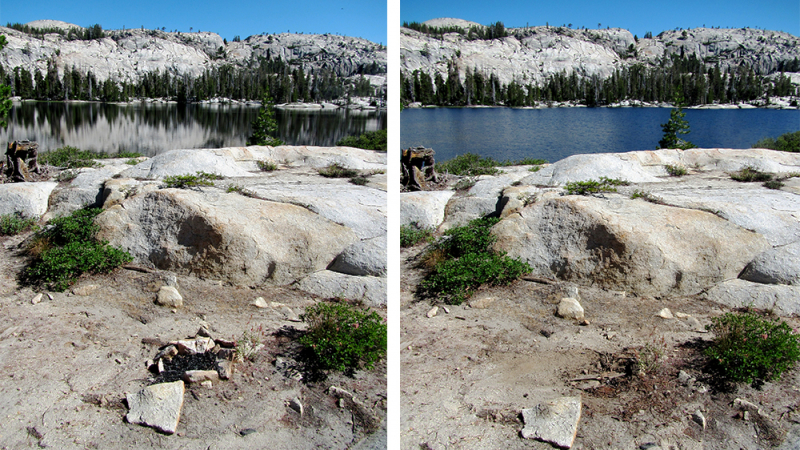
A Keep It Wild crew restored this backcountry campsite that was too close to the water at Many Island Lake (left – before restoration; right – after restoration). Photo: Courtesy of NPS
While restoration crews spend a lot of their backcountry time finding and maintaining, reducing or removing campsites, that’s just one part of their long list of wilderness to-dos! During summer seasons in the wilderness, they also…
- collect and pack out discarded items, such as (and yes, these are real examples) aluminum foil, empty cans, frying pans, free weights, a car battery, an eight-person tent, old bear-proof canisters and a rubber raft. Crews estimate that they pack out around 100 pounds of litter per year.
- restore ruts and hiker-generated “social trails” that parallel formal, maintained trails or create unnecessary shortcuts. (For details on that process, check out our blog post about the multiyear effort to repair ruts along the popular John Muir Trail in Lyell Canyon.)
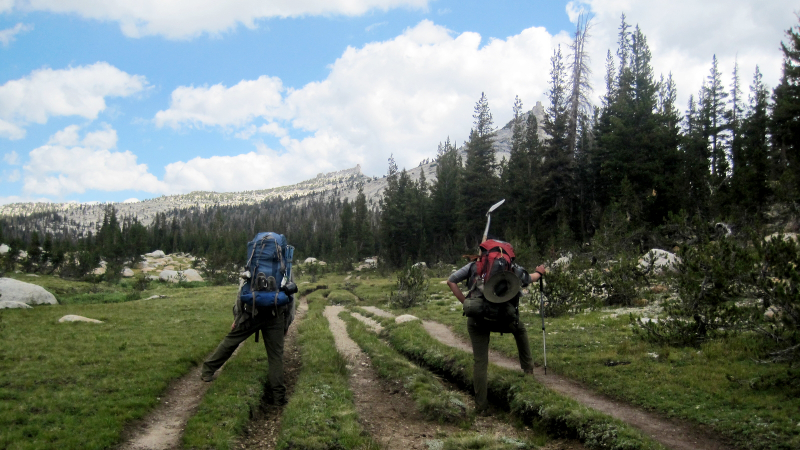
Ruts can form when hikers (and horses) step off established trails to avoid mud and water. Photo: Courtesy of NPS
- work with archeologists to protect cultural resources. Crews learn how to distinguish historical objects from modern-day debris, and record any notable findings from the field. Archeologists survey potential restoration sites in advance, and collaborate with crew members to protect artifacts.
- map and remove invasive vegetation, such as bull thistle, velvet grass and yellow salsify, using grid searches, in which crew members space themselves out along a horizontal line and walk forward together, scanning the ground for high-priority plants.
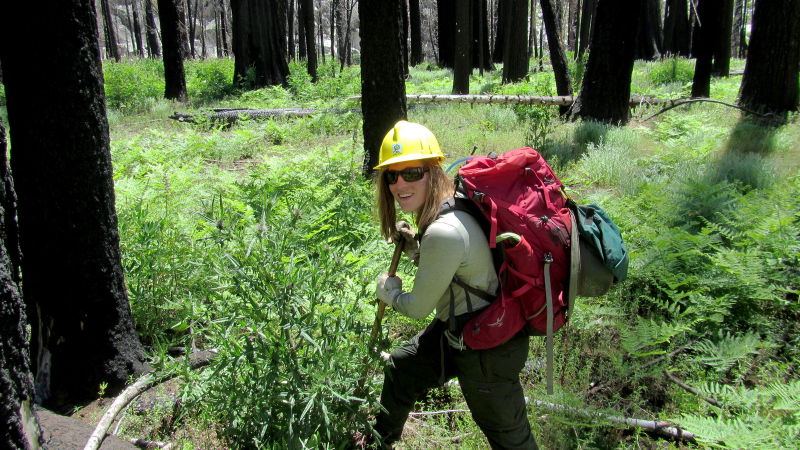
A restoration crew member digs up invasive bull thistle in Yosemite’s Lost Valley. Photo: Courtesy of NPS
Now that you know a little more about what goes into restoring wilderness areas, let’s go back to that secluded lake we described at the beginning. Instead of pitching your tent by the shore, where you could damage plants, soil and water, pick a spot a little farther away. Walk 40 paces from the trail, and see if you can find a previously used site — in Yosemite, you’ll often be able to find a spot where someone else has already camped. If you can’t find one, look for hard ground with minimal plant cover.
Want to build a campfire? Be sure to check fire restrictions in the park before you head out. Find an existing ring, use only dead, fallen wood, and make sure it’s completely extinguished before you go to bed. If you can’t find a ring, don’t build a new one. Skip the fire that night, and enjoy the stars! In the morning, sweep the site for stray gear or food scraps.
If you follow those steps, you’ll help remove a to-do from the restoration crews’ list … and we bet you’ll appreciate your backcountry surroundings even more, knowing that you helped play a part in protecting the Yosemite Wilderness.
You can pitch in without pitching a tent, too! Join our community of Yosemite supporters to help fund projects to restore and protect wilderness areas.
Source: Cole, D. N. & Monz, C. A . (2003). Impacts of Camping on Vegetation: Response and Recovery Following Acute and Chronic Disturbance. Environmental Management, 32(6), 693-705.
Source: National Park Service Visitor Use Statistics (Overnight Stays by Category)

